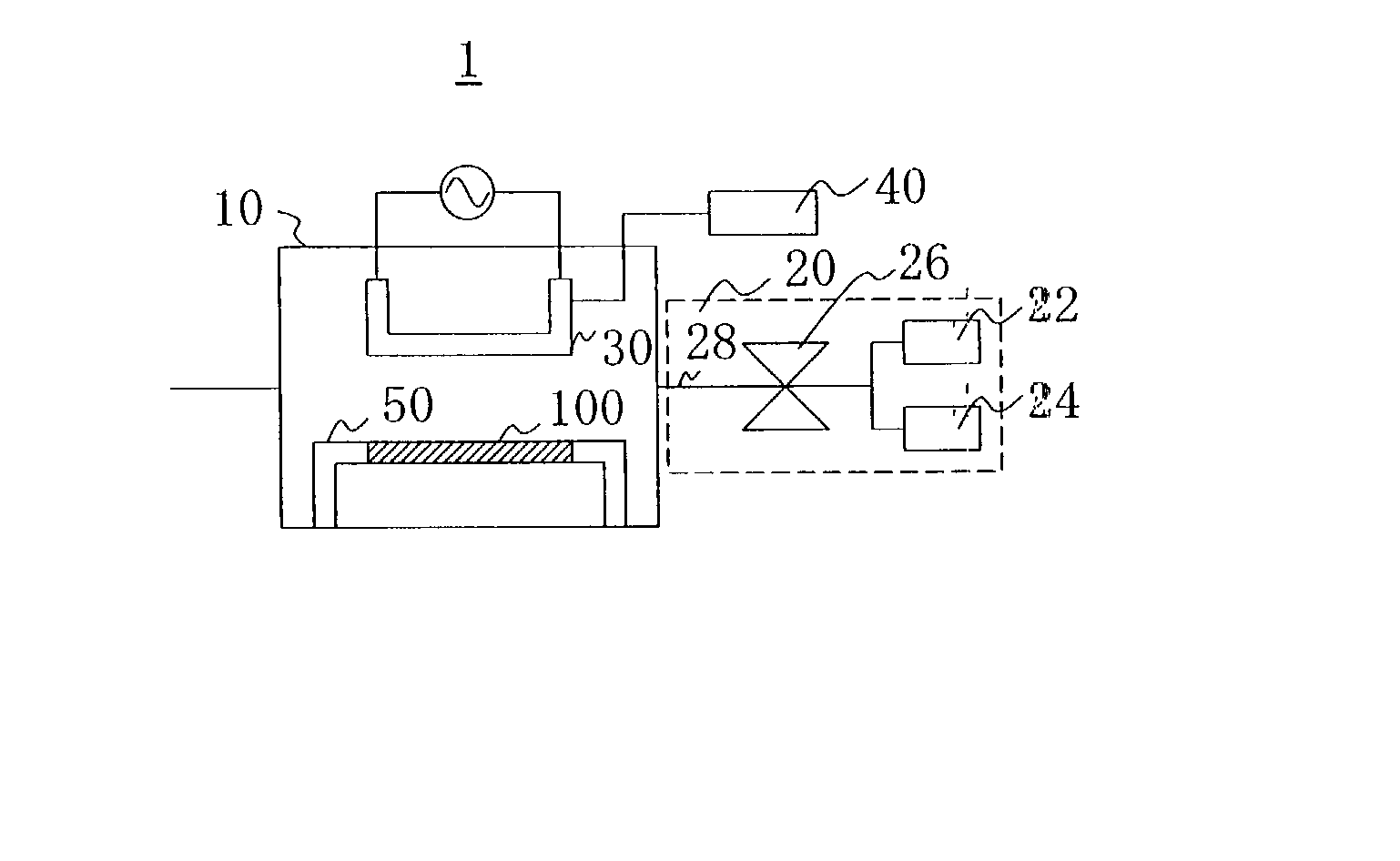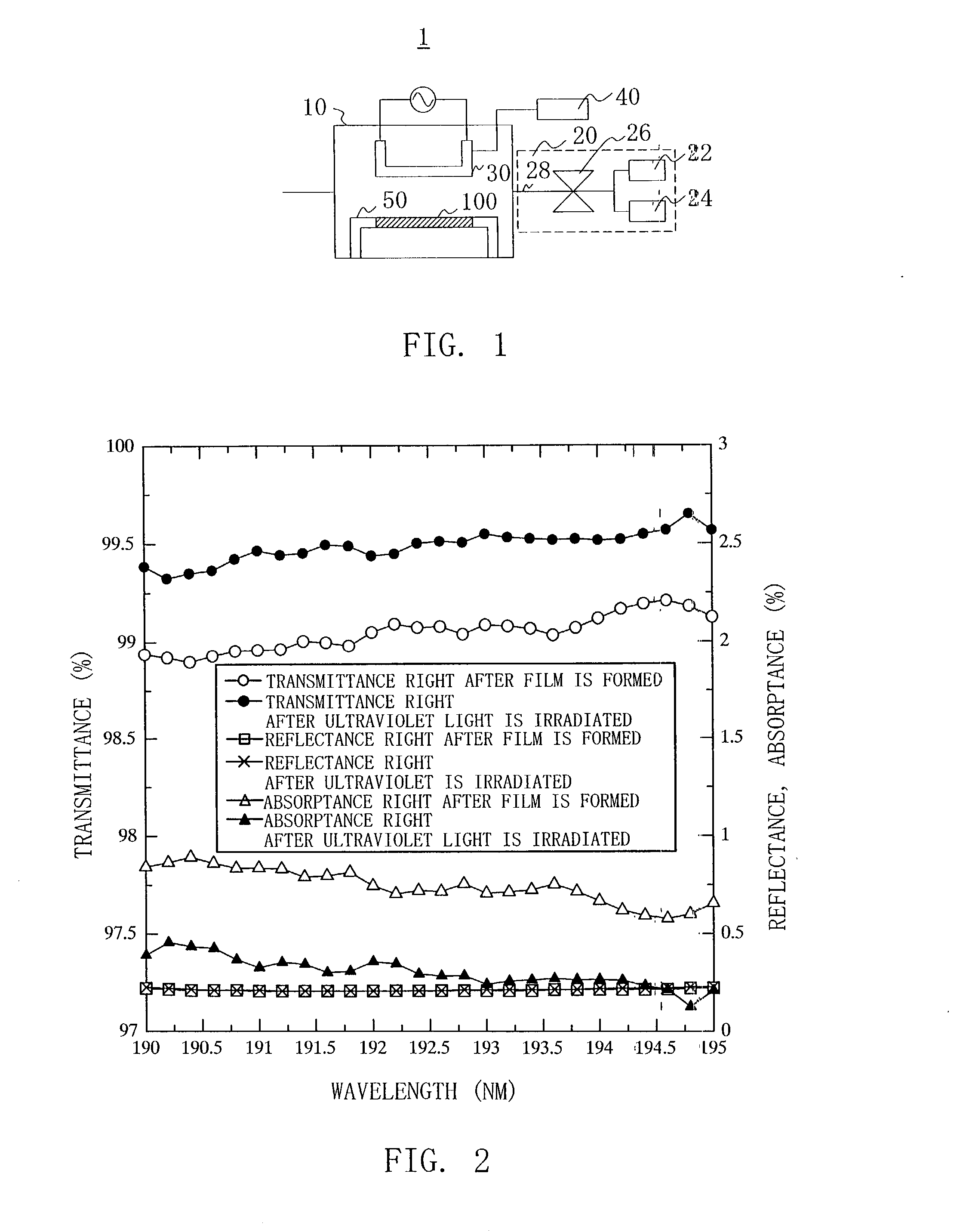Optical element fabrication method, optical element, exposure apparatus, device fabrication method
a technology of optical elements and fabrication methods, applied in the direction of lens, crystal growth process, nuclear engineering, etc., can solve the problems of generating optical absorption, deteriorating optical characteristics of optical elements, and damaging the substrate and thin film formed on the substrate, so as to reduce optical absorption and excellent optical characteristics
- Summary
- Abstract
- Description
- Claims
- Application Information
AI Technical Summary
Benefits of technology
Problems solved by technology
Method used
Image
Examples
example 2
[0038] At first, a thin film of magnesium fluoride ("MgF.sub.2") with a thickness of about 100 nm was formed by vaporizing the magnesium fluoride while heating it with an electron beam, onto a flat CaF.sub.2 substrate with a thickness of 2 mm, both of whose surfaces are polished to be used as the substrate 100. As soon as the thin film was formed, the transmittance and reflectance of this optical element was measured using a spectrophotometer to calculate an optical absorption factor.
[0039] Next, this optical element was irradiated by a low-pressure mercury lamp for one hour (where it is assumed that the irradiating section 30 of the optical irradiation apparatus 1 is a low-pressure mercury lamp). After this optical element was irradiated by the low-pressure mercury lamp, its transmittance and reflectance was measured again by using the spectrophotometer to calculate its optical absorption factor.
[0040] The calculation result of the optical absorption factor at the wavelength of 248...
example 3
[0041] Similar to the second embodiment, a thin film of MgF.sub.2 with a thickness of about 100 nm was first formed by vaporizing the MgF.sub.2 while heating it with an electron beam, onto a flat CaF.sub.2 substrate with a thickness of 2 mm, both of whose surfaces are polished to be used as the substrate 100. As soon as the thin film was formed, the transmittance and reflectance of this optical element was measured using a spectrophotometer to calculate its optical absorption factor.
[0042] Next, this optical element was irradiated by KrF excimer laser for 30 minutes (where it is assumed that the irradiating section 30 of the optical irradiation apparatus 1 is KrF excimer laser). After this optical element was irradiated by the KrF excimer laser, its transmittance and reflectance was measured again by using the spectrophotometer to calculate its optical absorption factor.
[0043] The calculation result of the optical absorption factor at the wavelength of 248 nm from the measured trans...
example 4
[0044] Similar to embodiment 1, an alumina thin film with a thickness of about 100 nm was first formed by the sputtering method onto a flat MgF.sub.2 substrate with a thickness of 2 mm, both of whose surfaces are polished to be used as the substrate 100. As soon as the thin film was formed, the transmittance and reflectance of this optical element was measured using a spectrophotometer to calculate its optical absorption factor.
[0045] Next, this optical element was irradiated by ArF excimer laser for one hour (where it is assumed that the irradiating section 30 of the optical irradiation apparatus 1 is ArF excimer laser). After this optical element was irradiated by ArF excimer laser, its transmittance and reflectance was measured again by using the spectrophotometer to calculate its optical absorption factor.
[0046] The calculation result of the optical absorption factor at the wavelength of 193 nm from the measured transmittance and reflectance was 1.5% right after the thin film wa...
PUM
| Property | Measurement | Unit |
|---|---|---|
| wavelength range | aaaaa | aaaaa |
| wavelength | aaaaa | aaaaa |
| wavelength | aaaaa | aaaaa |
Abstract
Description
Claims
Application Information
 Login to View More
Login to View More - R&D
- Intellectual Property
- Life Sciences
- Materials
- Tech Scout
- Unparalleled Data Quality
- Higher Quality Content
- 60% Fewer Hallucinations
Browse by: Latest US Patents, China's latest patents, Technical Efficacy Thesaurus, Application Domain, Technology Topic, Popular Technical Reports.
© 2025 PatSnap. All rights reserved.Legal|Privacy policy|Modern Slavery Act Transparency Statement|Sitemap|About US| Contact US: help@patsnap.com



